Charging your batteries is a necessary evil while away from the dock. Most boats achieve the large portion of this via alternators, which have traditionally been less-than-optimal in terms of charge control. The Wakespeed WS-500 regulator changes all of that, and then some.
As part of my updated power system on Rendezvous, I added LiFePO4 batteries and a larger inverter. You can read more about that system at Victron + Wakespeed + Battle Born power system.
This was a great capacity increase, but it would not be effective unless I could charge it quickly and efficiently. My initial plan was to update the older alternators with newer higher capacity models, and install a set of Balmar regulators.
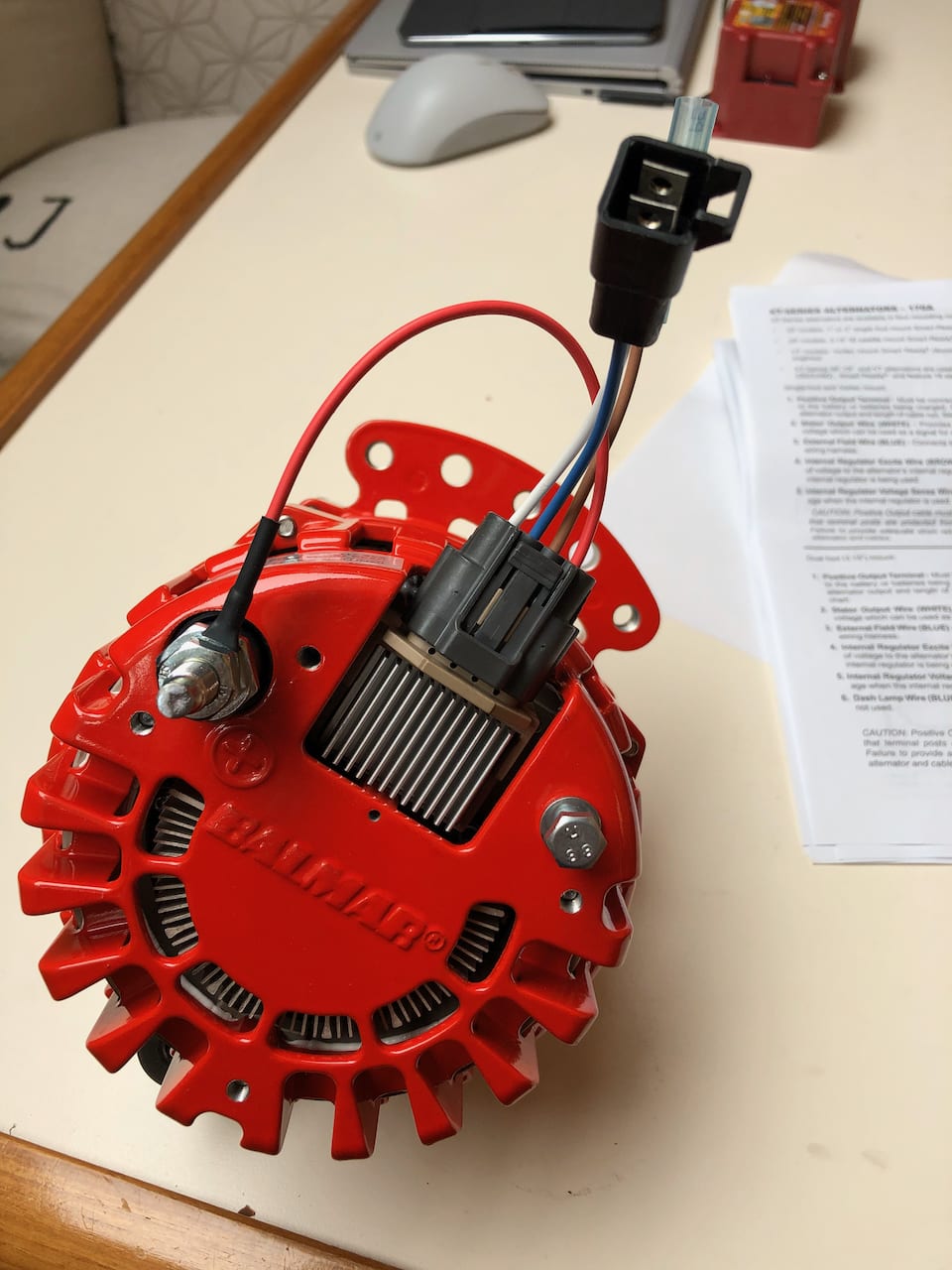
One approach is to set both alternators to the same charging profile and hope that things work most of the time. This can work, although I have seen it not work a lot more frequently. On a dual engine boat long ago in my past, I would generally only see one alternators capacity worth of charging, even though I had them both set to charge. Granted, this was with two banks and a combiner relay, but still.
Another approach is to have one alternator charge the start bank, and one charge the house bank. Since the start bank rarely needs more than a few minutes to top up after being used to start the engines, that seemed like a phenomenal waste of a new alternator.
After considering the overall design, I decided to have both alternators from the main engines charge the house bank, which added some challenges in terms of charging efficiency. You can see more details on this configuration and how I keep the start and generator banks charged (DC-to-DC chargers) in the article above.
To get the best efficiencies out of this setup, I needed both alternators to work together so that neither one was working too hard. I also really wanted a lot better control over the charging profile, as alternator regulators are notorious for being far less “nice” to batteries than standard AC-based chargers.
Why I chose the Wakespeed WS-500 Regulator
I considered various options including the Balmar MC-614 + Centerfielder II, Electromaxx, and a few others.
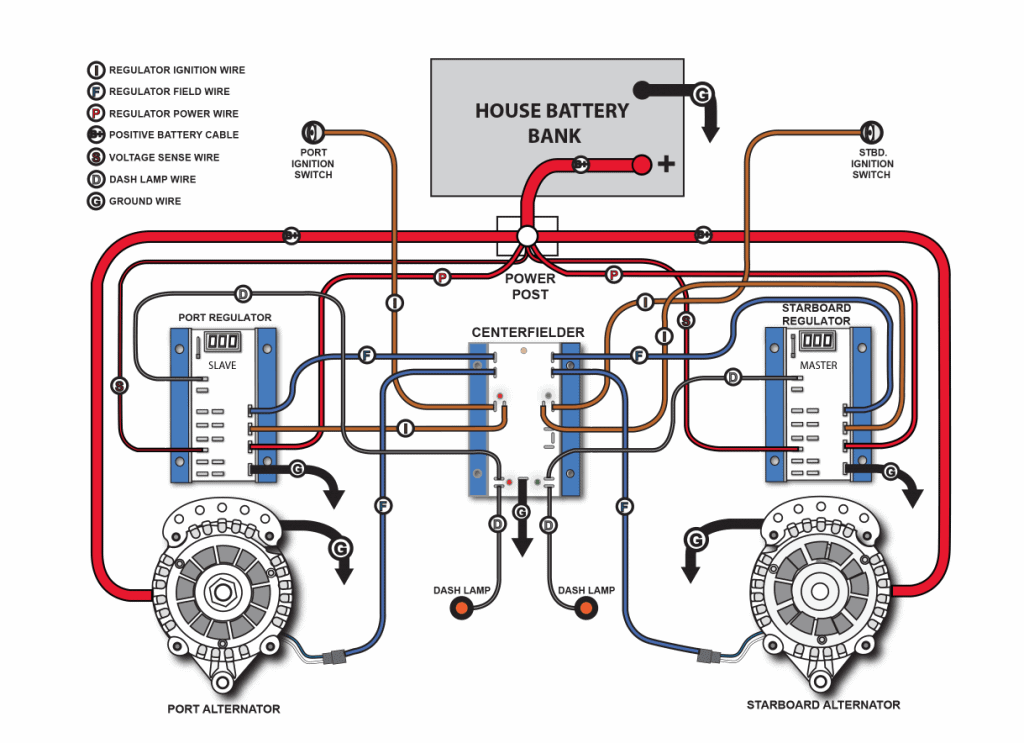
Most of them had pretty complicated wiring and setup processes, and limited control over charging profiles and settings. They are very tried-and-true, and have a lot of people using them, but I was hoping for something a bit more modern.
I eventually found the Wakespeed WS-500 and contacted them for more info.
Al Thomason and Rick Jones both replied to my initial inquiries about the WS-500, and a long, detailed discussion ensued. I’ve known Al for a few years, and had in the past exchanged some nerdy, detailed emails with him on CAN bus and NMEA 2000 along with battery monitoring, but I didn’t realize he had been involved from the beginning with Wakespeed. Rick Jones worked for Balmar for a long time and experienced many of the challenges in the alternator charging world. The third partner, Michael Frost, was responsible for several of the long-running designs of Balmar products including the Max Charge and ARS voltage regulators. Sadly, he passed away in 2016 but Al and Rick continued on.
This is all relevant, as these guys have a serious pedigree in the alternator and charging world, which went a long way with me trusting to install this rather new technology in my brand new battery bank setup!
After a detailed review of my system and design, which I was in the middle of implementing, Rick and Al recommended two WS-500’s and gave me lots of helpful information on where to start.
What’s Included
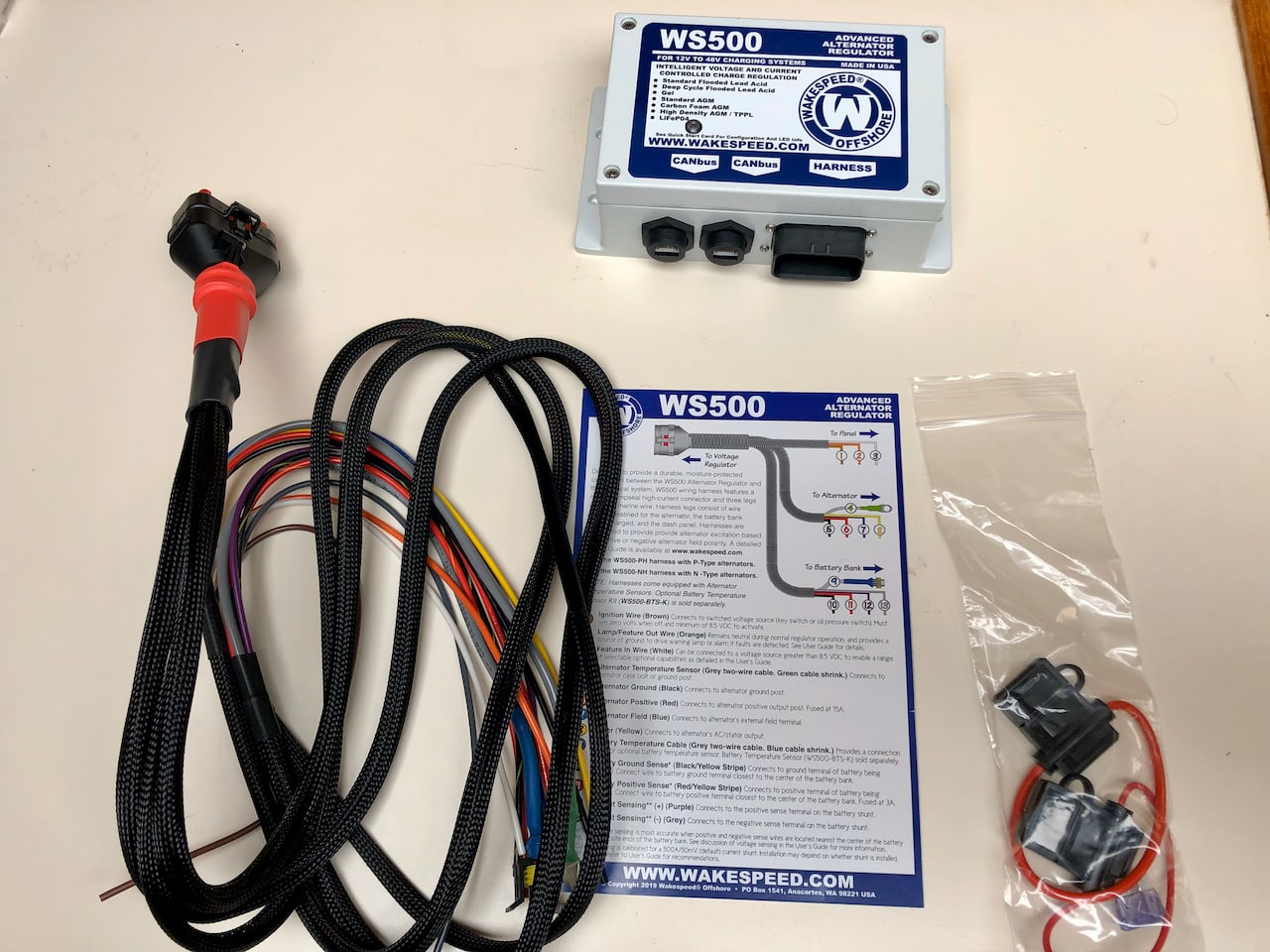
With each regulator you get:
- Regulator
- Main cable bundle
- Fuses for several connections
- CANbus terminator
- Installation card/diagram
You can find all of the included documentation, and a lot more, at the Technical Information page on Wakespeed’s website. I bought two regulators, one for each engine/alternator combo.
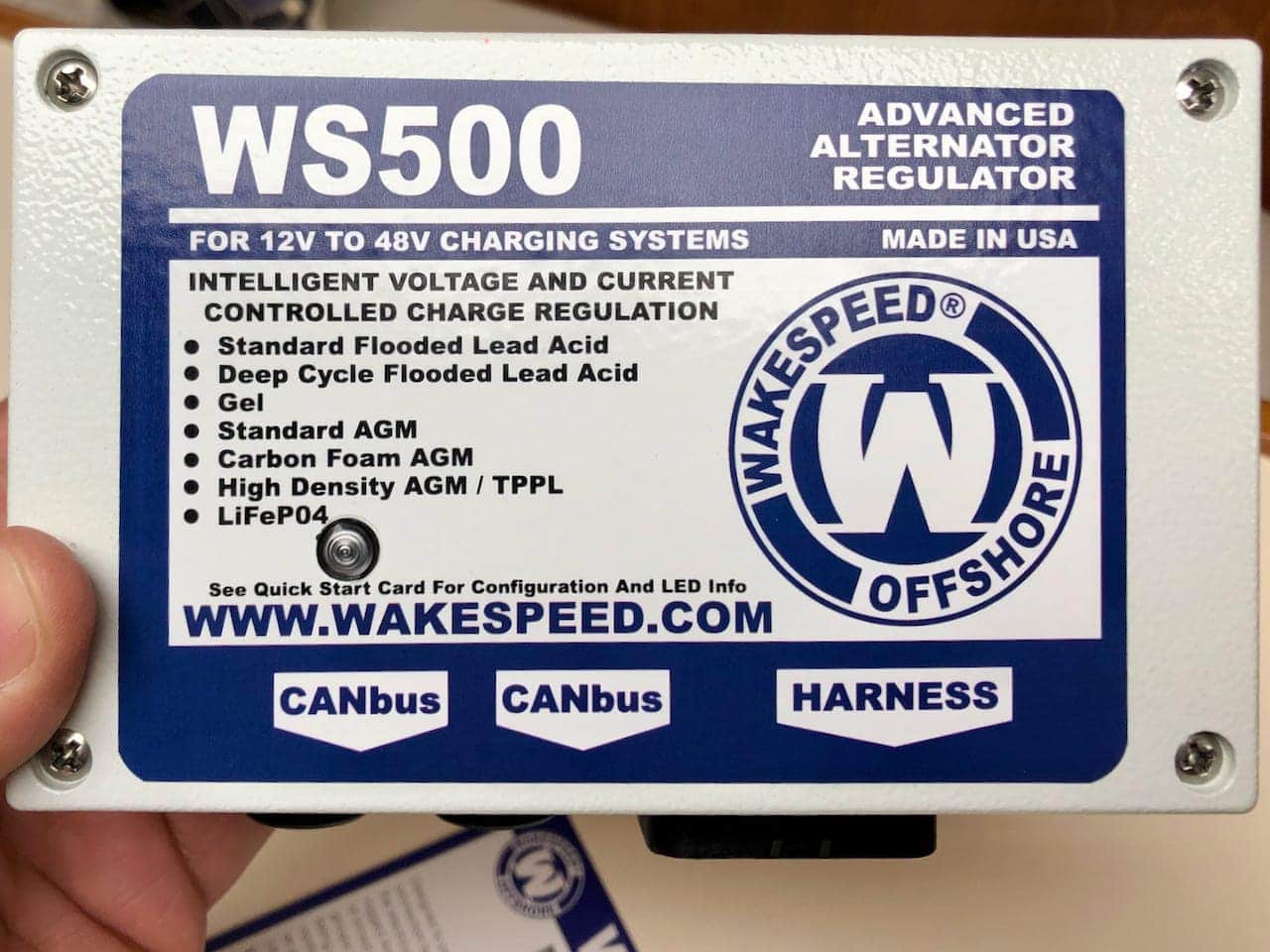
The regulator itself is beefy and has some connectors on the bottom, and an LED light on the top to indicate various states. The top cover is secured by four screws.
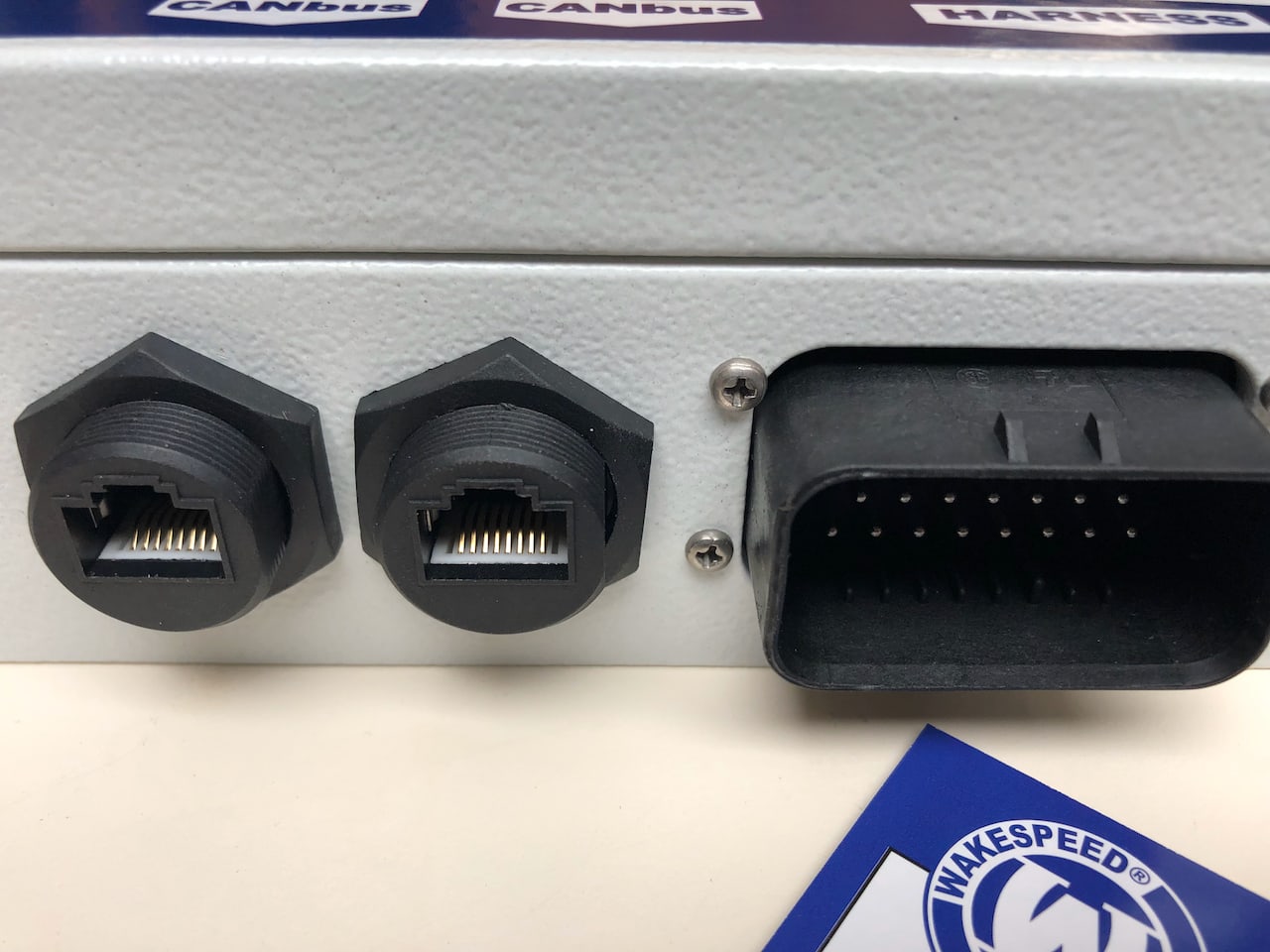
The connectors on the bottom include two CAN ports and one large connector for the cable bundle. I used the CAN ports to connect the two units, which allows them to work together very efficiently. In addition, the provided terminators were placed in the other ports. The ports use J1939 CAN so there are opportunities to connect and control using a BMS or other external system. Wakespeed have a lot of really cool plans and already existing installs that leverage this open standard.
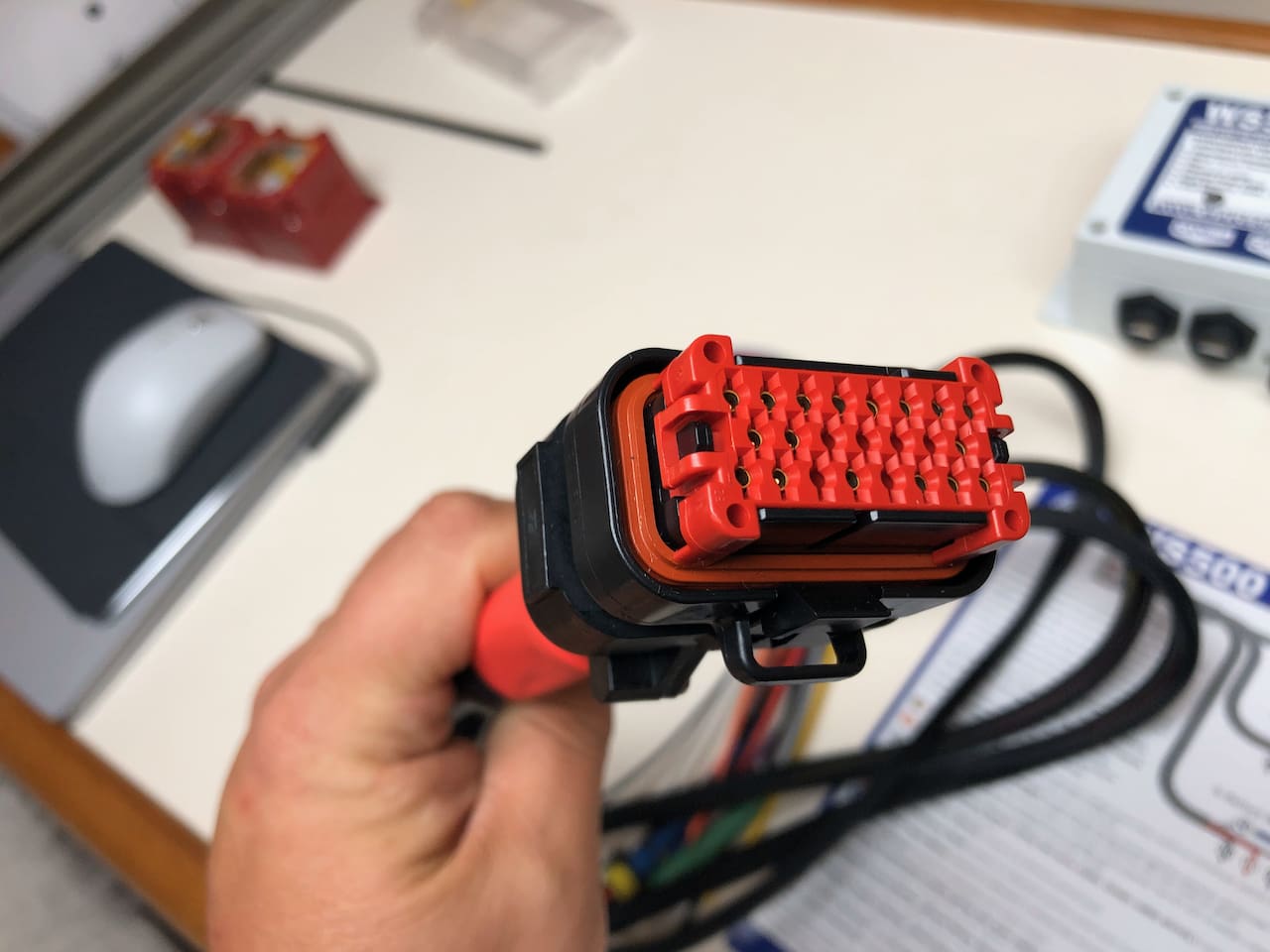
This is the regulator side of the cable bundle which uses a beautiful connector. Wakespeed has both P and N type wiring harnesses depending on your alternator type.
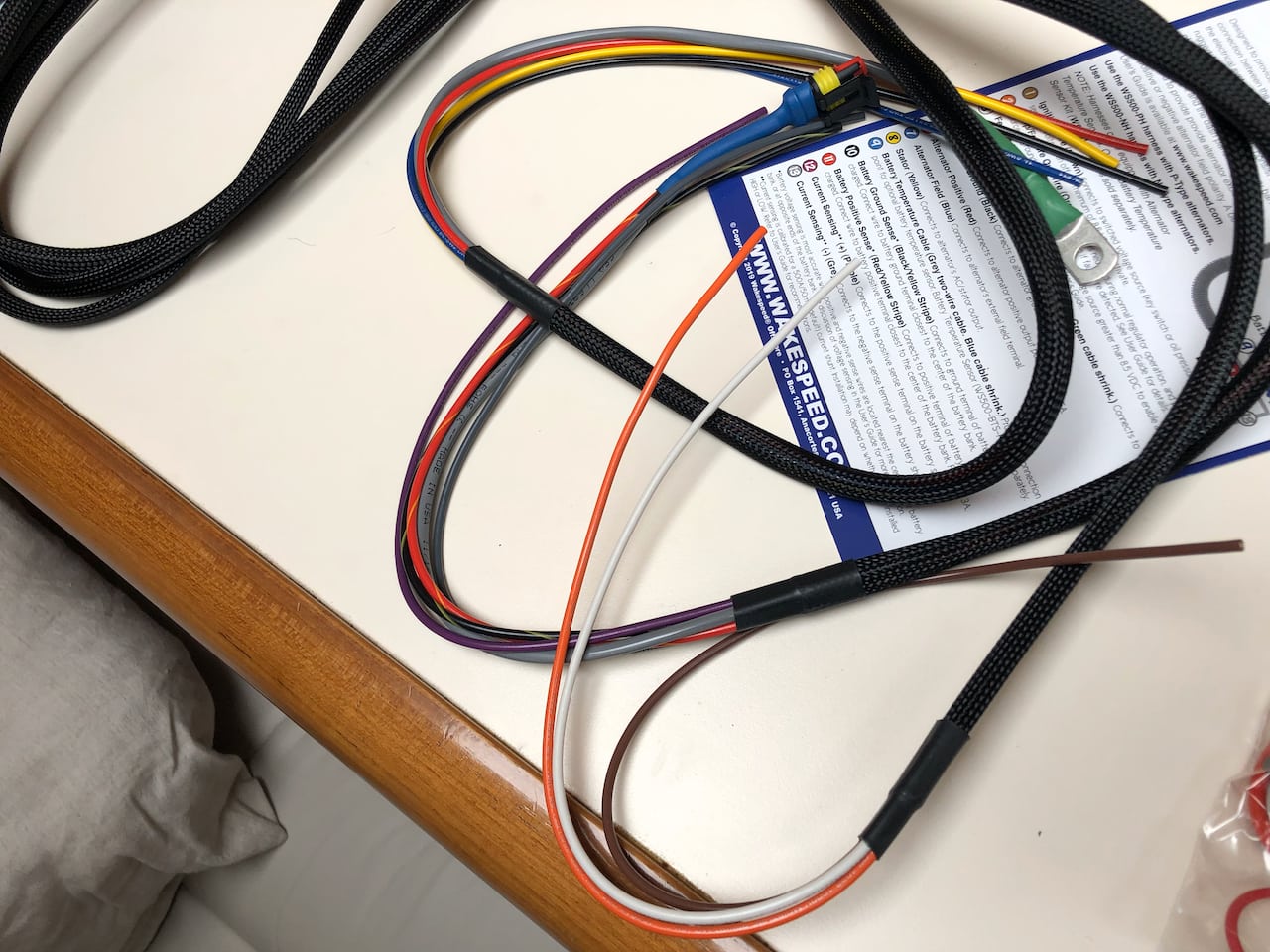
The wiring harness includes three main groupings – alternator, battery and dash. There are fuses included for those wires that require it, and the whole harness is fairly long so you could potentially not need to extend them.
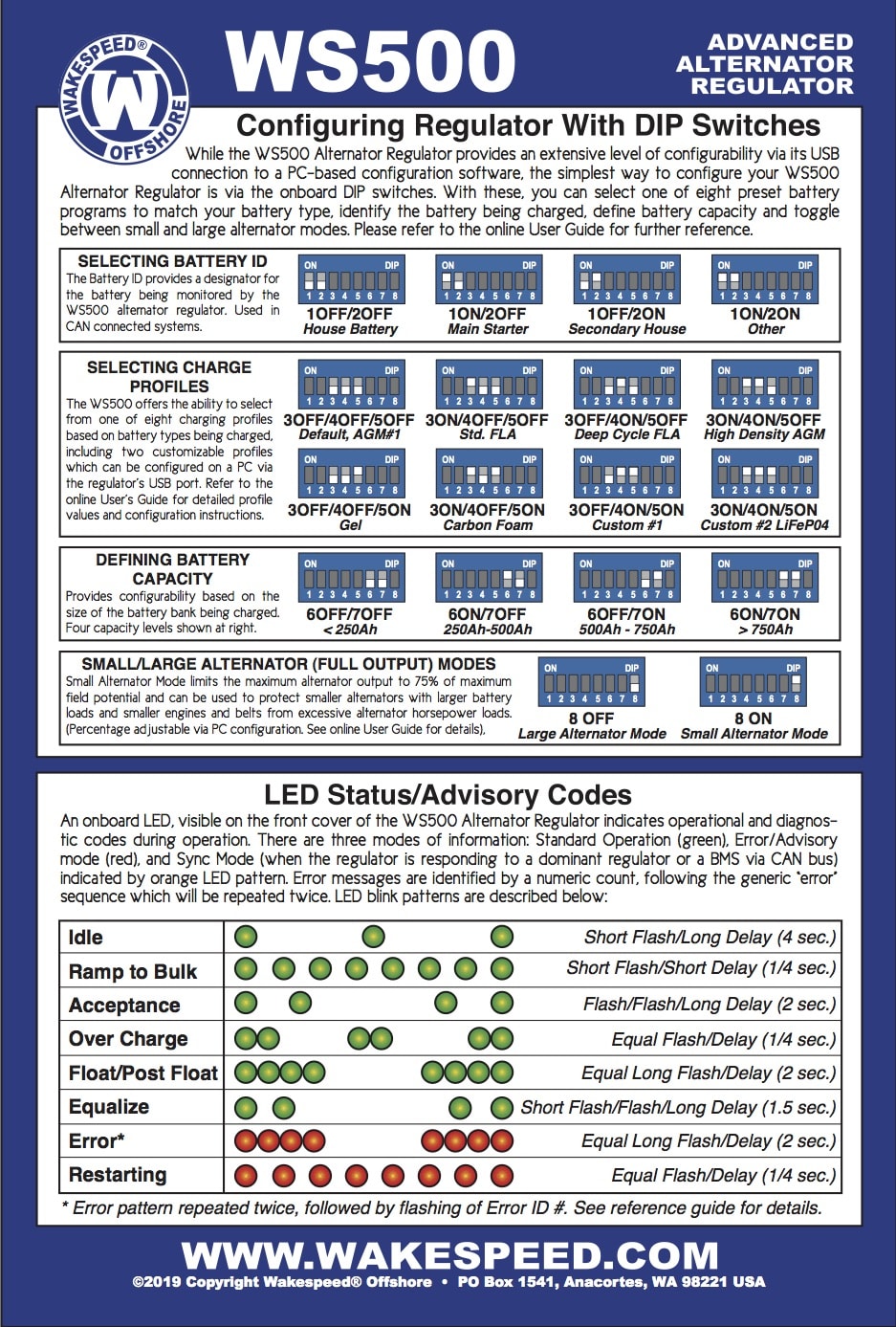
There is an included Quick Start card which is one of the best I have seen in a long time. It has clear directions, but most importantly, big pictures showing how the DIP switches should be set for charging profiles. The second page shows the wiring harness with really nice big numbers and colors, making it very easy to set things up and get connected.
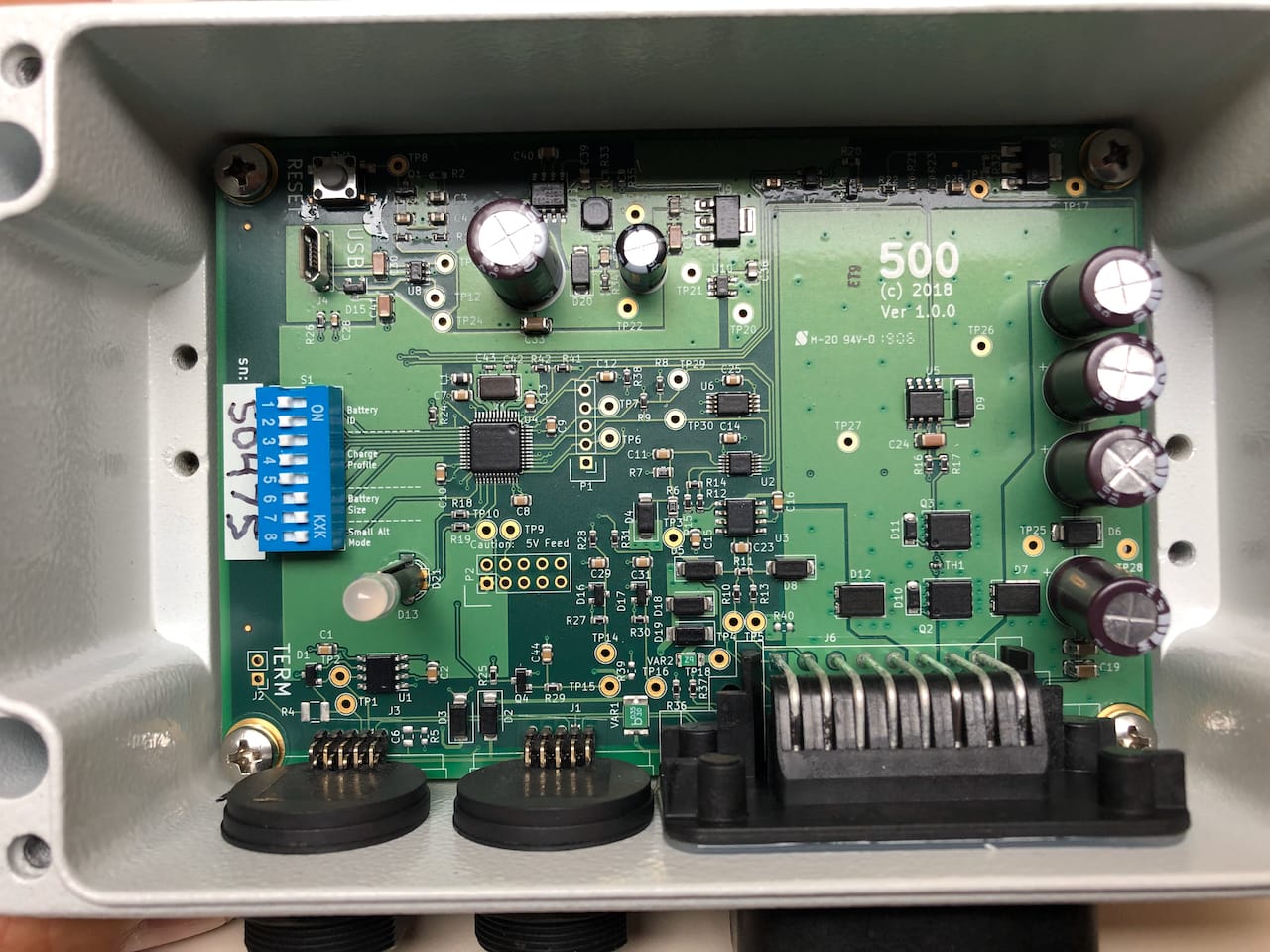
Inside the regulator is the main control board which includes the DIP switches and also a USB port for computer configuration. You’ll need to access this to configure the unit – either to set the DIP switches or connect to the USB port.
Features
Charge Control
The biggest difference with the WS-500 over other systems I have used is the data it utilizes to make charging decisions – battery voltage, battery temperature, alternator temperature and current. Most regulators only the first few, and not the current flowing to/from your battery bank.
This results in a far more predictable charging result, similar to what you would see from a standard AC charger. For LiFePO4, Firefly and other charge-sensitive banks, this is a perfect solution, as you not only can configure the WS-500 using a PC to be very custom, but it actually drives the alternator so accurately due to all of the data being gathered that you end up with a proper charge system.
In addition, each phase of the charge cycle can be adjusted and tuned exactly for the battery bank and type you have. This includes not just voltage, but overall time, how many amps are flowing, temperatures, etc. etc. etc.
Dual Engine Support
This was one of the main features I was interested in the Wakespeed product, and it does not disappoint. Simply connecting an ethernet cable between the two units CAN ports ensures they communicate between each other to operate in the most efficient way possible. Seriously, all I did was plug in a cable, and I now have a dual regulator, dual alternator solution that is terrifyingly efficient. If you look at other solutions out there, this sort of setup requires a ton more work.
Zero Output
This allows the regulators to monitor the current shunt and reduce the alternator output to match the house loads once the batteries are charged. This is a really important feature for batteries that, once charged, should be left alone and not constantly discharged.
Adaptive Idle
This feature allows you to set an RPM level for when the load should be increased on the alternator, and a weight for how quickly it should be increased.
This one makes me the most excited, and I don’t know why other manufacturers haven’t figured this one out yet. I have tried a couple of solutions that attempted to do this, but were not implemented well or didn’t work.
The WS-500, already being connected to the alternator, has an idea of RPMs based on the pulses it is seeing from the alternator. With a bit of math using the size of the engine flywheel + the size of the alternator wheel, you can configure the WS-500 to see the actual RPM of your engines.
Even though I have two rather beefy 305HP engines, at a low idle of 600 RPM they tend to not like a lot of extra load on the alternator. In the default configuration, my field values for the alternators were at about 50%, causing the engines to idle rougher than I wanted. Using this feature, I was able to tell the WS-500 to not bother starting the field until I hit 900 RPM, and even then to phase it in slower than the default profile.
As a result, I have nice idle speeds from the engines, no rough idle, and I don’t have to worry about any effects on control while at these speeds.
For smaller engined boats such as a sailboat, this feature will be critical, and result in good engine performance while close quarters maneuvering, while still taking advantage of higher RPMs while out on the water.
Computer Configuration
Because of the USB port, you can configure and monitor every aspect of the regulator. No magnet and tiny displays in cramped spaces, hoping you get things in the right order the first time after tap, tap, tapping. Plugging a standard USB cable into a PC provides the regulator with power so you can configure it ahead of final install, which is a really nice feature. The regulator shows up as a standard COM port, and there is an extensive Communication and Configuration Guide that gives you access to every part of the software.
Other Features
There are a lot of other useful features on the WS-500 including the ability to use the CAN ports for BMS compatibility using RV-C and OSEnergy protocols, 100’s of charge profiles / combinations, custom presets, and firmware updates.
Configuration
Configuration can be done two different ways – simple or more advanced. The simple method is using DIP switches. The more advanced requires a computer and USB cable. I chose the more advanced method because I was programming mine very specifically for my Battle Born LiFePO4 batteries.
I chose to use a Windows machine and putty to configure things. The Communication and Configuration Guide provides the details around how to configure it for the serial connection – port speed of 115200, with local echo forced on.
Once connected you should start seeing data appear, which is the regulator sending it’s status and other information every second or so.
AST;,0.00, ,12.91,-32.4,-32.4,-419, ,14.60,375,15000,20, ,-99,19, ,200, ,12.91,26,-99,1AST;,0.00, ,12.91,-31.2,-31.2,-403, ,14.60,375,15000,20, ,-99,19, ,0, ,12.91,26,-99,2AST;,0.00, ,12.91,-30.3,-30.3,-391, ,14.60,375,15000,20, ,-99,19, ,190, ,12.91,26,-99,1AST;,0.00, ,12.92,-29.2,-29.2,-377, ,14.60,375,15000,20, ,-99,19, ,175, ,12.92,26,-99,2SST;,AREG2.0.2, ,0,0, ,8,1.50,1.00, ,0,0, ,0,-1, ,0AST;,0.00, ,12.91,-31.1,-31.1,-402, ,14.60,375,15000,20, ,-99,19, ,0, ,12.91,26,-99,2AST;,0.00, ,12.91,-29.9,-29.9,-386, ,14.60,375,15000,20, ,-99,19, ,215, ,12.91,26,-99,1AST;,0.00, ,12.92,-31.5,-31.5,-407, ,14.60,375,15000,20, ,-99,19, ,0, ,12.92,26,-99,2Each line starts with a three letter identifier that ends with a semicolon, along with comma separated data afterwards. In the above example we have the AST and SST identifiers which are for Alternator Status and System Status respectively. This set of data is from my already configured regulator, so it is showing battery voltage (the 12.91 number) along with current flowing from my battery bank, charge voltage goals, and much more.
You can query the regulator with many different commands to find out not just status, but the charge profile that is being used, more details on temperatures, and a wealth of other things. In addition, you can change just about any parameter you could think of – from a completely custom charge profile, to how fast the regulator ramps up, alternator size, max amps, and many more.
$CPA:7 14.5, 200, 40, 0To change a configuration value, you only need to find the setting you want to change (which can take some time since there are a lot) and send it a command via the serial connection. The above command is changing charge profile #7 (one of the custom ones) to charge to 14.5 volts, and to exit after 200 minutes or when the system reads less than 40 amps.
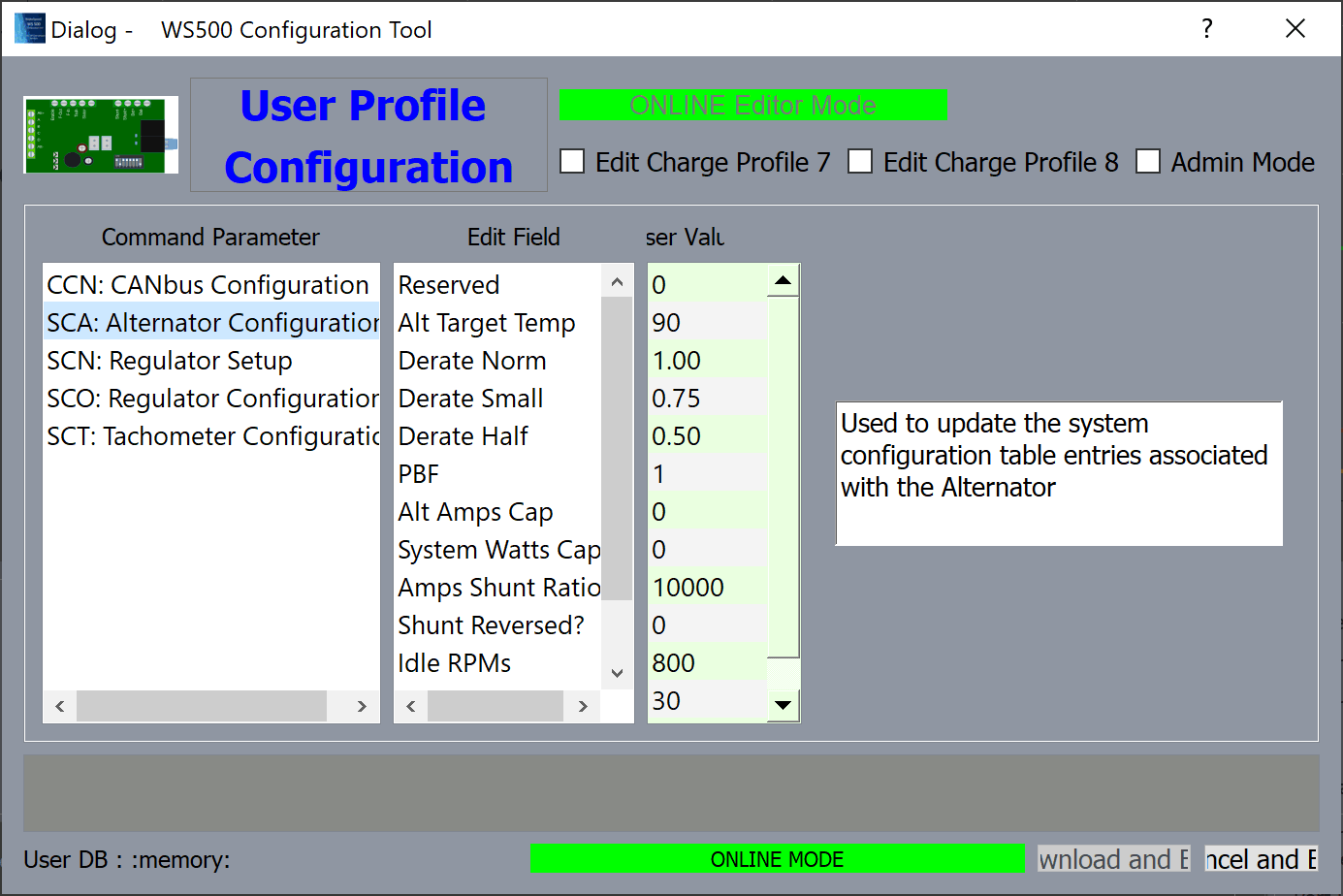
If you prefer a graphical way to configure things, Off Grid Marine Energy Products has collaborated with the Wakespeed folks to make a Windows-based configuration and monitoring tool. It has a menu-based system allowing you to see all of the configuration values along with help tips on each, and ways to save and restore configuration easily. I’ll show a bit more about that later under the Performance section.
I ended up configuring my units to use the same exact charge profile that Battle Born provided to me for the Victron MultiPlus inverter/charger. I used charge profile 8. I’m charging to 14.6 volts for a maximum of 200 minutes or until 15 amps or less are seen.
No additional configuration is required when using two units – just connect them with an RJ45 cable, and they magically start working perfectly in tandem.
I’d like to see more connectivity options, and Wakespeed has been very open to ideas around this. Having to use the USB cable is fine, but you can’t get to the USB port without opening up the case. This means the inner circuit board is exposed during that time, and really shouldn’t be left open in normal operating conditions.
Installation
Once I finished configuring the units, I set about the physical installation. For my setup, I was able to site the regulators on a bulkhead forward of each engine. The cables from the regulator went to two main areas – one bundle to the alternator, and one bundle to my main DC power area, also nearby.
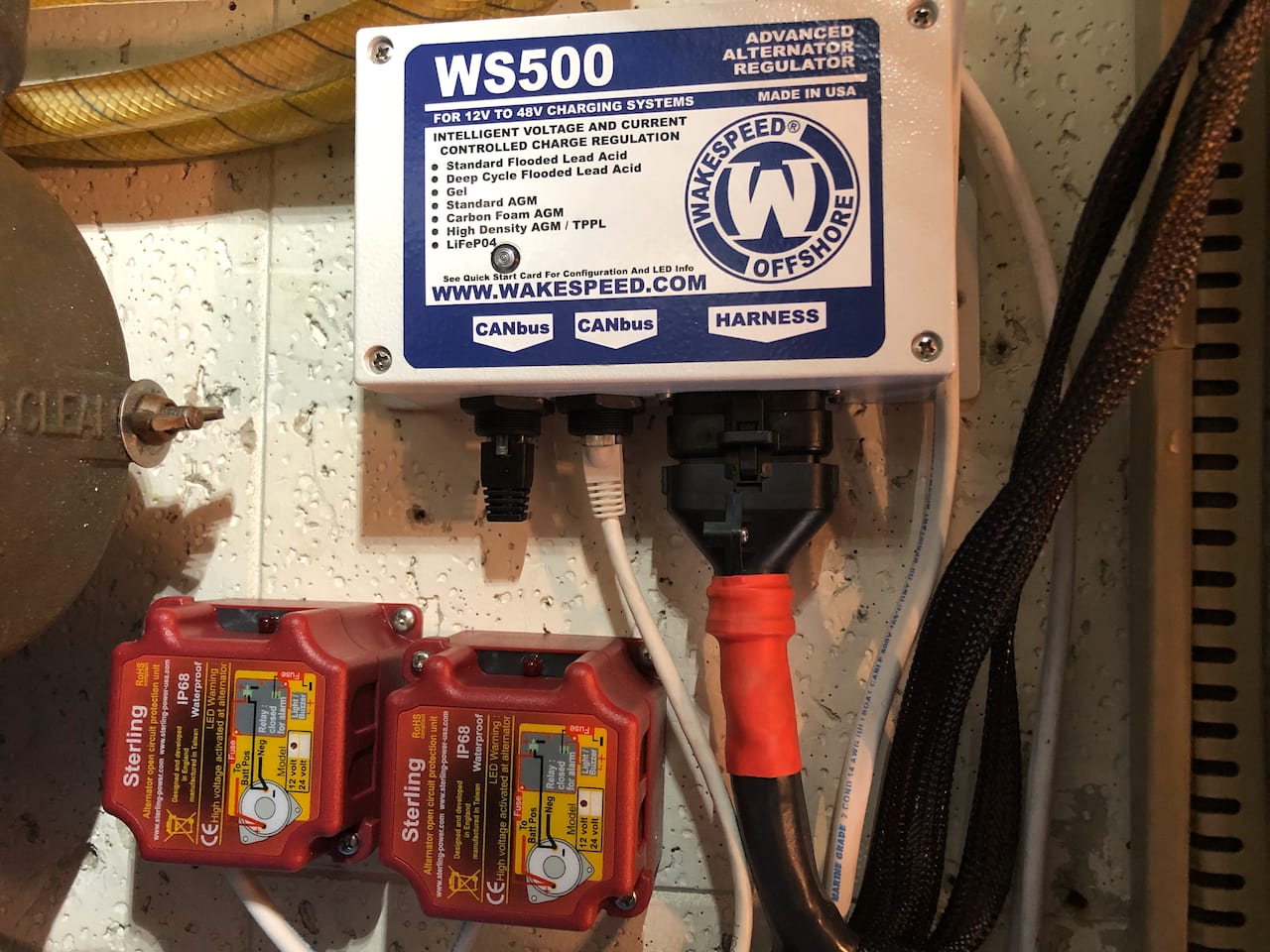
Bundle 1 to the alternator contains the dash and alternator wires. The dash wires provide power to the regulator, which I connected to a nearby oil sensor that only comes on when the ignition is turned on. The other wire was for a warning alarm which I connected to my existing warning alarm wire.
The alternator wire bundle includes the alternator negative and positive, field, stator, and temp sensor. These I connected to the matching points on my alternator.
Bundle 2 went to my DC power area and contains the battery temp, negative and positive battery sense, and current high/low sense. Since I’m using LiFePO4 batteries, I did not need to use the battery temp sensor. The positive and negative battery sense wires went right to the main bus that the battery bank main cables connect to. The current sense or shunt wires I connected to my existing Victron BMV-712 shunt. A shunt is critical / required to the Wakespeed working correctly – you can buy a standard shunt if you don’t have one already.
The wiring was all very well documented in the getting started card, and was easy to connect to the various places. Make sure you follow all of the usual regulations and requirements when doing this part.
Also, make sure you read the installation instructions carefully – as an example, it is very important to get the shunt data from as close to the battery bank as possible. The Wakespeed guys have given a lot of thought to the installation to try to make it as clear and reliable as possible.
Software
As I mentioned above, Off Grid Marine Energy Products has collaborated with the Wakespeed folks to make a Windows-based configuration and monitoring tool. It is really well thought out for setting things up, as well as monitoring while tuning your setup.
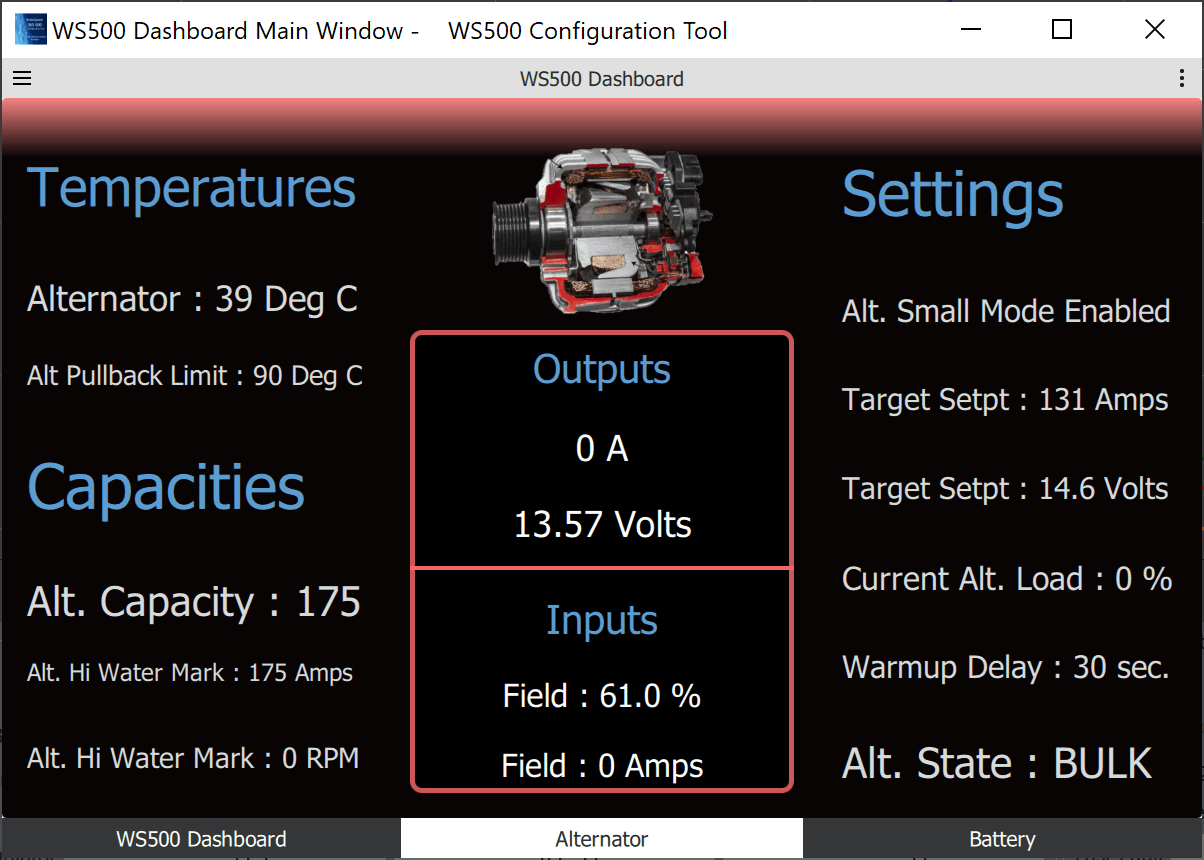
There are also some helpful dashboards available which show general overview info, alternator details, and battery bank status as well.
They also sell the WS-500, and have some good bundle deals both for the regulator and software combined. The price of the software is completely worth it, not only to simplify the configuration, but to use in tuning and monitoring your setup, which you will see below.
Performance
I’ve been using the Wakespeed WS-500 regulator since May 2019 and have put more than 200 hours of motoring time on it. This included one month-long trip from Seattle -> Desolation Sound and back, with the regulators and alternators doing 95% of all charging the entire trip, and large daily discharges running ice machines and freezers in the warm temps.
I’ve made some configuration changes along the way to optimize charging, and based on feedback from the Wakespeed folks, but generally speaking, the WS-500’s have been running flawlessly since I installed them.
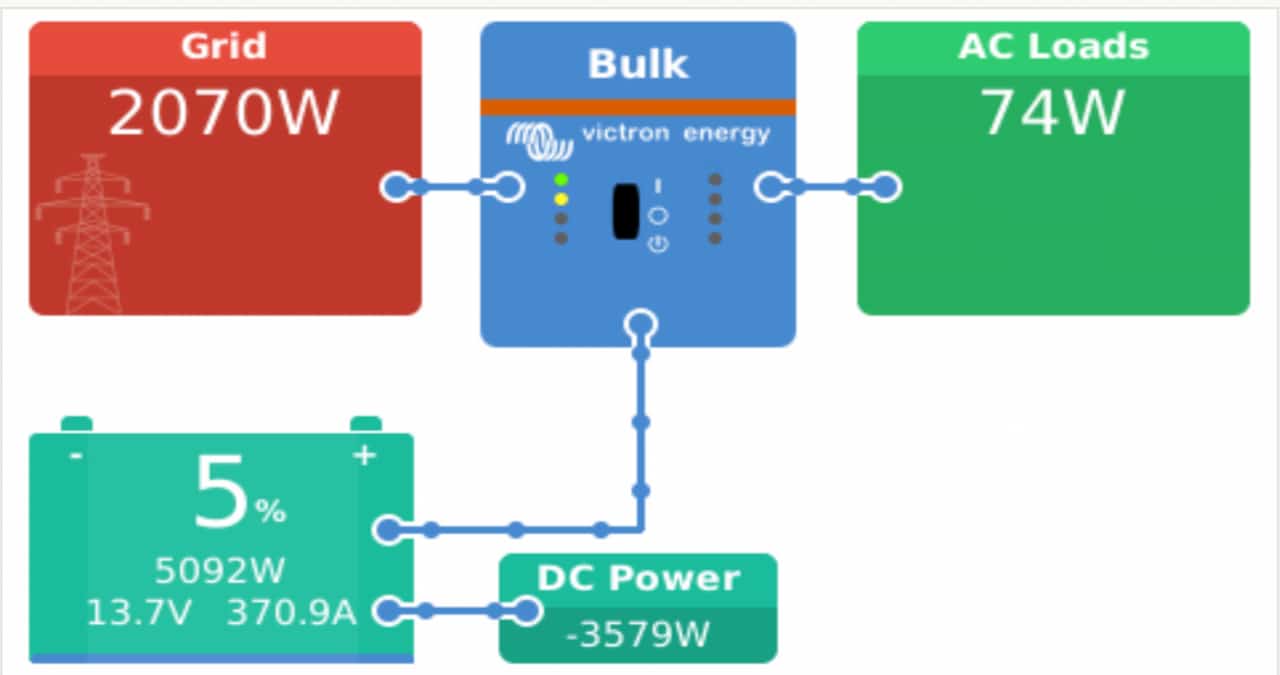
Above is my Victron Color Control GX showing 370 amps flowing into my house battery bank. This was underway after being at anchor for several days, and I had about a 30-35 amp draw of various things running. That puts me close to 400 amps of total charge capacity, which was 2x Balmar 175 amp alternators and the Victron MultiPlus inverter/charger pumping 120 amps, which was running off of the generator. That means I was charging at about 280 amps from both alternators combined, or 140 amps each. For a 175 amp small case alternator, that is pretty good. I had them running at this level for most of those 200 hours without any issues.
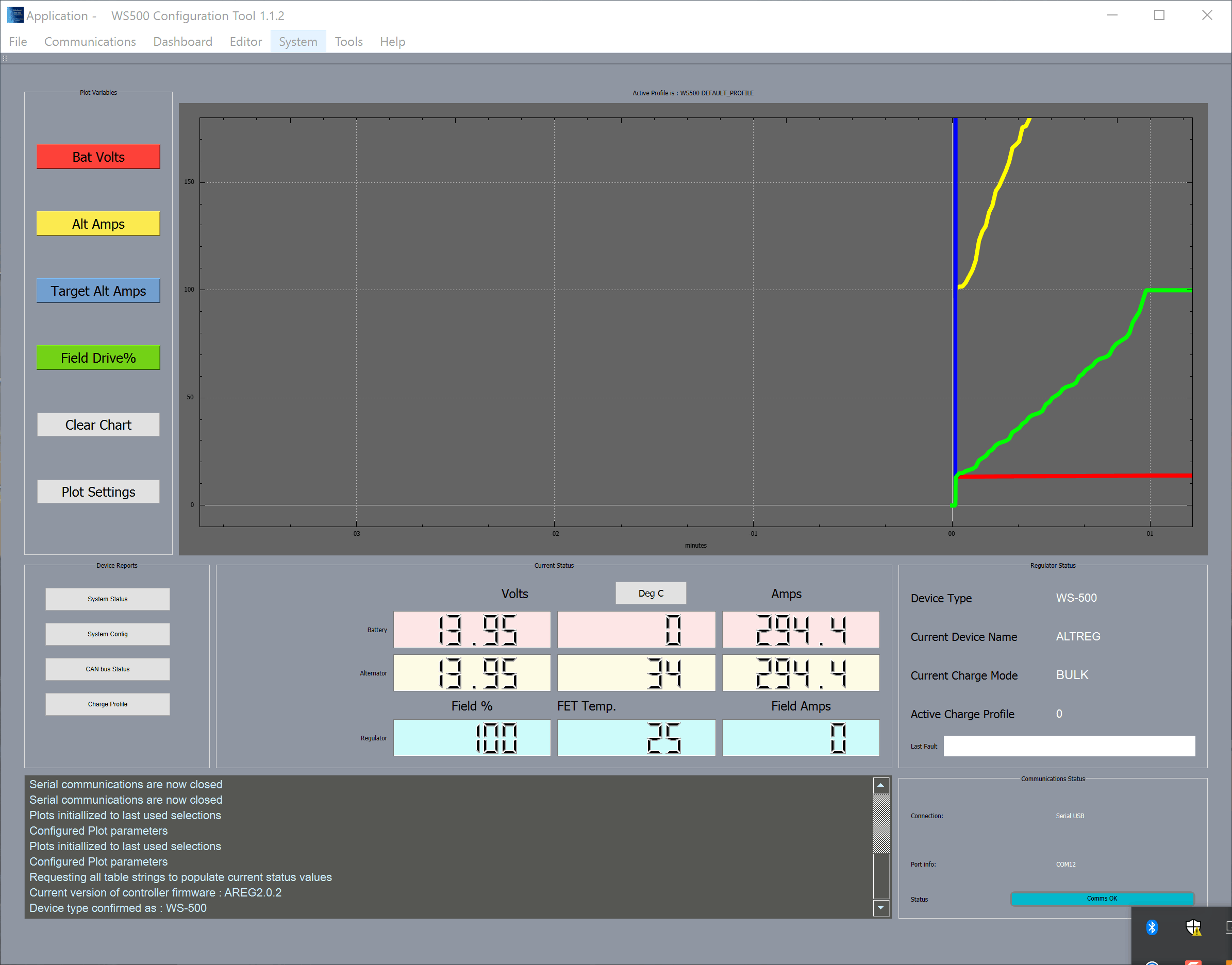
Using the WS500 Configuration tool allows for a real-time display showing various performance graphs. In the image above, I’m connected to one regulator out of two, and seeing the initial ramp up phase after I started the main engines. I’m still seeing the single shunt on my house bank and the overall amperage coming/going to it from not only the regulator I’m connected to, but the matching one on the other engine, and all other charge/discharge sources. This is where the WS-500 excels above most other solutions in taking that metric into account when charging, not just voltage and temperature.

Here’s further along in the charging cycle and you can see that my alternator temperature has risen to 65C (149F) from the initial 34C (93F) at the start of ramp up. Being able to see this real-time on a graph is amazing, and super helpful to tuning your alternators to their max capacity without overheating.
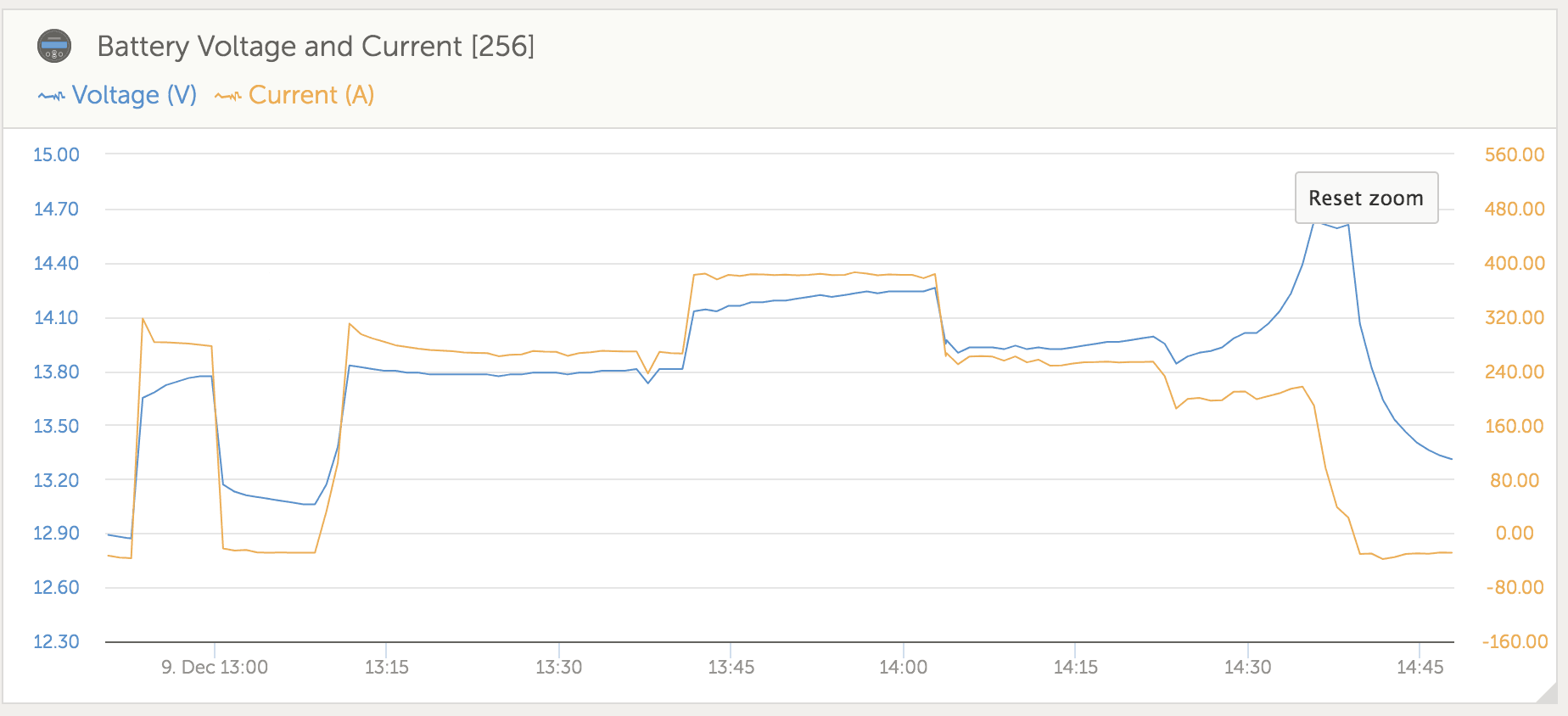
Here’s another test run that I did during an actual trip, and the Victron VRM portal data showing my battery charging rates. During this part of the trip, I experimented with running the alternators alone, and also with the generator powering the Victron MultiPlus inverter/charger, which added about 120 amps of charging capacity. You can see when the generator is turned on around 13:45, and back off again around 14:00. You can also see the end of the charge cycle around 14:40 or so when the battery voltage spikes up, and the inbound current decreases.
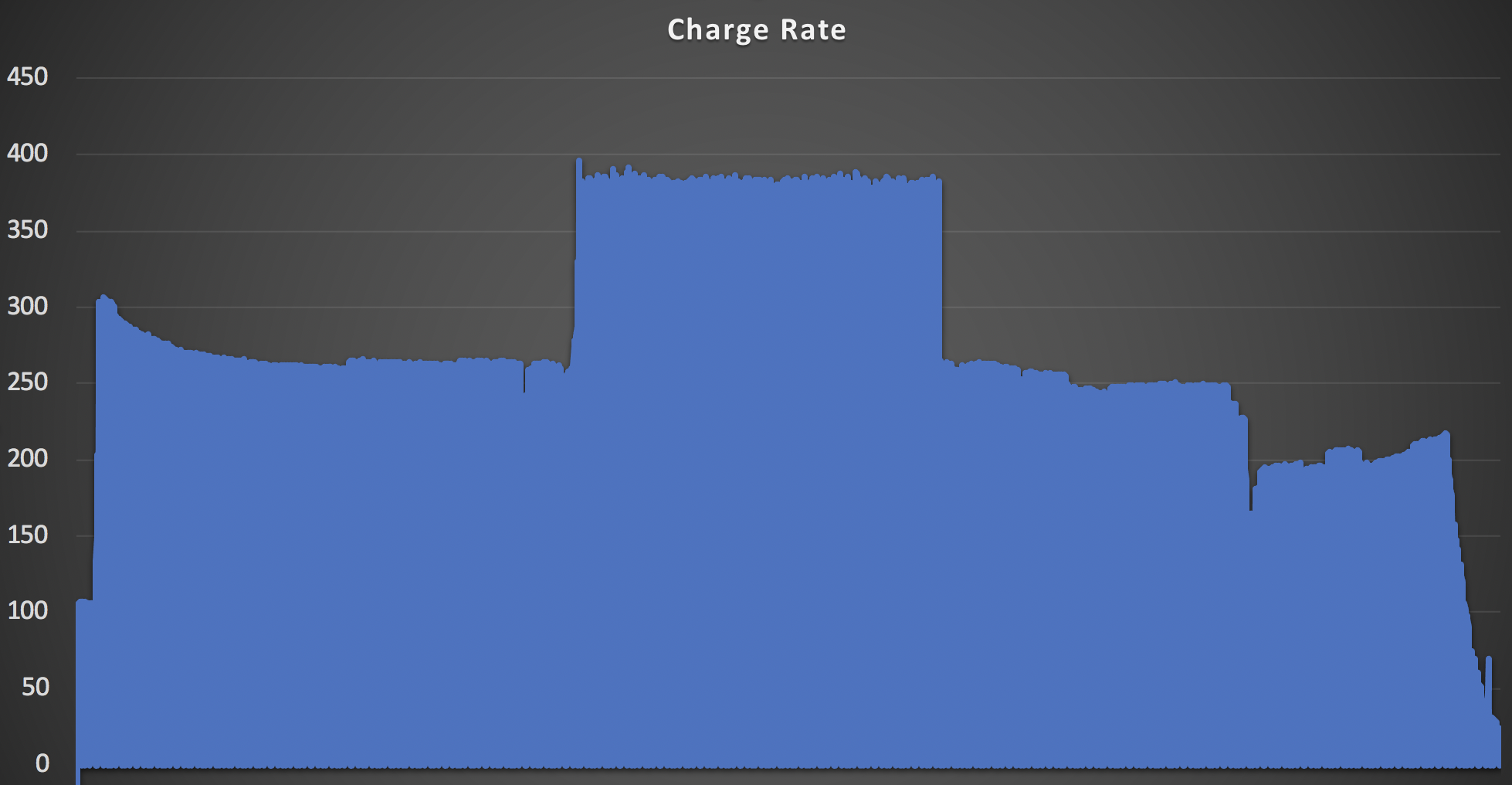
Here’s another look at that same trip, but just the middle part during the generator test, with data from the Wakespeed WS-500. I gathered this using putty on the Windows machine, logging all of the data, and importing it into Excel for analysis later.
The trip was from Poulsbo / Liberty Bay to Seattle / Elliott Bay Marina and the total charge time was around 2 hours, starting at a 28% state of charge (SOC) on my house battery bank.
Conclusion
My new electrical system would not work anywhere near as well without the WS-500. Using traditional alternators and control systems, I would either get only a portion of the overall charge capacity at times, or have voltage / current regulation issues which would charge my batteries at less-than-optimal settings.
The dual-engine performance has been absolutely amazing, and I can charge my entire 600 amp hour LiFePO4 bank from almost 0% SOC to full in about 2 hours. That is a super short amount of time, and allows me to do short 2-3 hour passages between anchorages, and arrive with a completely full bank for longer times at anchor without the generator.
Pros
- Significantly better charge control / profiles
- Monitors the same data a proper AC charger does
- LiFePO4 & BMS compatible
- Tons of configuration options
- Idle and RPM-aware
- Excellent for dual alternator / engine setups – no config required
- Lots of logging / excellent Windows software
- Great support
Cons
- Configuration can be complex with so many options
- Access to USB port requires opening case
The WS-500 represents the next-generation of regulators that uses proper, detailed data to charge your battery bank, like a high quality AC charger. This results in far more efficient and safe charging, while having amazing networking abilities for multiple units, providing coordinated bulk charging, and detailed logging. If you have a large house bank, a sailboat with a smaller engine, or batteries that require a more strict charging profile, the Wakespeed WS-500 is something you should seriously consider.
Archived Comments
These are read only comments from the old system. Scroll down to participate in SeaBits Discussions, our new interactive forum attached to each article.
ML_C36
July 26, 2019 at 3:59 pm
Steve, have you written more about the Electromaax system? I personally have the generation before the one they are selling now and have some strong views but wanted to get your take.
- Steve Mitchell
July 26, 2019 at 4:33 pm
I have not written more about Electromaxx for a couple of reasons. First, I sold Grace last year and have a completely different system on my new boat. Second, I had a moderate amount of difficulties with the system, and was able to correct almost all of them after a lot of back and forth with the manufacturer. There were still a couple of items that I was never able to resolve, and ended up having to work around in different ways. However, the system did provide more charging amperage than any other system I tested on Grace, albeit with some quirks.
This whole area of alternator control is one that I am surprised has not had more innovation for smaller sailboat motors. There are some new products out, one that I am testing now, and some that are looking very interesting that could help.
Always interested in hearing other folks opinions on a system as well! - ML_C36
July 26, 2019 at 3:59 pm
First, thank you for your extremely well put together articles. My office is right next to Peter Kennedy’s in Annapolis and I look forward to working with him on my LiFePO4 upgrade next year once my pockets have a bit more cash in them.
With regards to Electromaax, I got on board with them about 5 years ago with the promise (as stated on their website and discussions with them) of an integrated system that would be able to be monitored via my onboard computer as well as over NMEA network. I had issues from the start including faulty temp sensors as well as a mis-wired alternator. I just learned that they are now in the BETA phase of a system that can be monitored through the onboard computer but not on NMEA network (5 years after them advertising it). I have had great technical help but had issues in other departments of the company. I love their ideas and motivation but I have found execution is well behind their vision. I also just went on their site and saw they are now advertising LiFePO4 batteries. I wish them well for they may now be producing a great product but based on my experience, I would never go with them again.
Mic
January 21, 2020 at 8:03 pm
Thanks for another great write up. I first became aware of Wakespeed back when it was first mentioned in the marine electronics press. Then, by coincidence, I met Al at a rendezvous last Sept and had a chance to talk to him in depth about what they were working on. I was really impressed. Since I hope to revamp my main electrical system in the near future your write-up has given me the detail and the confidence to put the WS-500 at the top the list for a regulator solution.
Keep up the great work!
Paul g
January 22, 2020 at 1:53 am
I noted your practice of running the genset while underway to add to your total charging current. I suppose that works as well as it does because of Lithium’ s very high charge acceptance rate. I have both my engine alternators’ output directed to the House bank via MC614 regs and a Centerfielder II and see around 145A in bulk acceptance. Running the genset powering a Victron inverter charger (nominally 120A but derated to 93A) the total charge acceptance only increases to about 185A. I suppose that reflects the limited acceptance rate of my flooded golf cart batteries (bank capacity of 940Ah)….or is it more likely to be charge “confusion” between the two charge sources (ie alts and a/c charger)?
Grant Jenkins
January 23, 2020 at 6:49 pm
Great article, Steve.
I’m curious though, about their reference to “CanBus” networks and connectors. Normally I associate that with NMEA2000, but the connectors are in fact RJ45, or what most of us think of as Ethernet, and the network protocol apparently is J1939. You know way more about this than I, so perhaps this doesn’t seem confusing to you, but I think when you mention CanBus in the recreational marine world, most folks think NMEA2000, no?
They also do not appear to have weatherproof connectors for the cables and terminators, although the fittings are threaded to accept them. This would give me a little pause in the engine room environment, I think…
- Steve Mitchell
January 23, 2020 at 7:31 pm
Hi Grant,
Good questions.
CAN bus (https://en.wikipedia.org/wiki/CAN_bus) is what NMEA 2000 is based off of. J1939 is also based on CAN bus and primarily used in trucks and busses for engine communications. I know that the guys at Wakespeed are a bit more open-source-minded when it comes to the protocols they use, and have tried to develop their product with that in mind.
Keeping that in mind, in order to have a true NMEA 2000 certified device, you have to go through a lot of hoops both financially and legally. I know that having a true NMEA 2000 certified port on the WS-500 is something many people (including me!) would like to see, and I did pass that along to them in my testing. I’ll leave it to them to provide any details on whether they are working on one.
I believe they chose the Ethernet port form factor to allow for a number of different options when it comes to interfacing. That gives them the flexibility to use it for CAN now, but also specific customized CAN versions or other similar protocols for BMS’es. That is an area they highlight in their marketing materials, and I would assume are pursuing with specific vendors and such.
Since the Ethernet cables are standard, you could get a weatherproof screw on one. I didn’t ask if they sell them, but I bet they do or have a way to source them.
Jenkins Grant
January 23, 2020 at 10:09 pm
Ok Steve, thanks – I’m aware of the certification costs for NMEA2000, I was just thinking the could have used the NMEA 2000 physical connectors on their CanBus device, much like other vendors have done, which would have been a lot more robust in the marine environment. But perhaps the 5-pin structure is insufficient for their design….
Mic
January 23, 2020 at 11:25 pm
Coincidentally, I was just looking at the Actisense website and noticed that they sell a weatherproof Ethernet connector, p/n RJ45-FFC.
https://www.actisense.com/products/rj45-ffc/
I’m sure you could get this OTS part from many vendors such as Mouser or Newark.
Looking at the Wakespeed Communications Guide
http://www.wakespeed.com/Wakespeed%20%20Communications%20and%20Configuration%20Guide%20v2.0.2.pdf
I see that you can put the CAN bus into a NMEA2000 comm mode. Although they recommend a CAN/NMEA2000 bridge to be on the safe side. That would be an interesting project for a rainy day.
Wolfgang Jansen
June 23, 2020 at 7:44 pm
By coincedence I stumbled over a project called “VSR Alternator Regulator”. See http://arduinoalternatorregulator.blogspot.com/
This open source project is the base of the WS500
Carl
October 30, 2020 at 6:18 pm
I’m considering using the Wakespeed on a cat with twin Yanmar sail drives as part of upgrading to the Balmar XT170 alternators. Yanmar engines have a well known problem of confused tachometers when charging from two engines. Do you know if the two inter-connected Wakespeeds will leave the tachometers working correctly?
David de Regt
November 8, 2020 at 7:00 pm
I was looking into getting some Balmar regulators and realized I should check your site to see what you’ve done. This solution is quite interesting, though a fair bit more expensive, and complicated to set up, than the Balmar stuff. Have you tried their NMEA 2000 update yet? It sounds a bit sketchy, especially in the dual-engine configuration, due to overlapping IDs and non-N2k frames being sent around. So I’m wondering if you’ve had any luck with it. But if I could get true charging info on my full N2k network, that’d be a big boon.
Steve
December 11, 2020 at 11:32 pm
Thanks for this well-written, informative review. I’m going to upgrade the engine charging system on my twin-engine catamaran using Wakespeed WS-500 regulators. I note that you used your Victron BMV battery monitor shunt for current sense. I would like to do likewise. Did you just connect the current sense wires to the screw terminals on the shunt?
Also, would like to confirm that no programming or other gizmos were required to have your two alternators play well with each other via the Wakespeeds. Just the CANbus cable connection between the two was required?
Thanks for all your great work. Love you blog!
DeWayne Enyeart
September 30, 2021 at 2:56 pm
Steve:
I am considering upgrading the alternator and regulator on my trawler to a Balmar XT-175 and a Wakespeed WS-500. Could you update your experience with these devices?
Thanks
- Steve Mitchell
September 30, 2021 at 3:41 pm
One of my XT-175s had a wiring issue and needed a small repair. Other than that, the alternators have been pumping out 140-150 amps each for many, many hours charging up my LiFePO4 bank.
The WS-500s have been a bit more challenging. A software upgrade caused one of the features I used to require a lot more configuration, and it took a few months of back and forth to get it resolved. They are still hands down the best regulators I’ve ever used, but you do need to be prepared for some programming and tweaking if you have a non-standard configuration.

